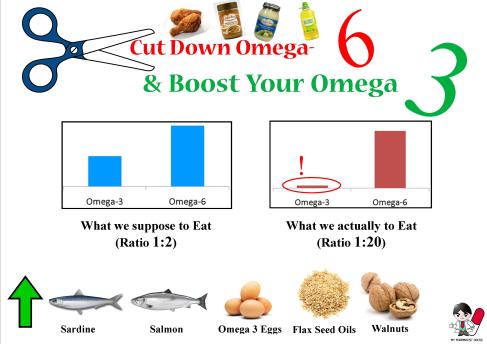Balance of Omega 3 & 6
Both Omega 3 & 6 are essential fatty acids which our body can’t make them, we need to take them from our diet daily. The problems of modern day are we consume too much omega 6 and too few omega 3 in our diet.
Omega 6 produce hormones (prostaglandins) that promote inflammation, cell growth and blood clotting whereas the Omega 3 produce prostaglandins with the opposite effect. For example, in the event of injury, you need to have a good inflammatory response to heal quicker as the inflammatory response brings blood and immune cells to the wounded area. But if you have not been hurt, an imflammatory response can damage tissue and cause major problems such as asthma, arthritis and heart disease.
Therefore, it is important that we consume Omega 3 and Omega 6 in a balanced fashion so that the hormones produced will be balanced. Unbalanced prostaglandin causes serious health problems such as cancer, heart disease, inflammatory diseases and autoimmune diseases.
So what are omega 6 fatty acids? These fatty acids are found in meats, margarines, peanuts, and many of our processed foods. Most of the foods we eat today are composed of omega 6 fatty acids instead of omega 3 fatty acids. The major sources of omega 3 fatty acids are found in cold water fish, flaxseed, soybeans, organic eggs and walnuts.
The oppose the effect of over omega 6 consumed, it it recommended that we consume these essential fatty acids in the ratio of 2:1, which means for the 20mg of omega 6 u consume, you must consume 10mg omega 3 to counter the effects.
Studies have proven that a relatively small number of omega-3 food sources can have a measurable impact on your blood levels of omega-3s, including those two key omega-3 fatty acids, EPA (eicosaenoic acid) and DHA (docosahexaenoic acid). For example, two weekly servings of a non-fried, omega-3 containing fish such as salmon is enough to boost your blood levels of omega-3s.
What foods provide omega-3 fatty acids?
Sardines, salmon, flax seeds and walnuts are excellent sources of omega-3 fatty acids. Very good sources of these healthy fats include cloves. Good sources of these fats include shrimp, cod, tuna, soybeans, tofu, kale, collard greens, and winter squash.


Few ways to cut your omega-6:
1. Change your cooking oils from vegetable oils to omega-3 rich oils
…………….
exposure to heat on omega-3 oils, omega 3 and other strongly oxides, and it almost becomes valueless